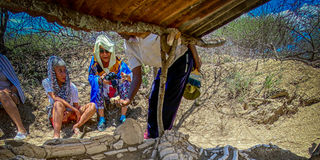Birds, elephants and fossil prints in Baringo historic sites

2.5 mya elephant fossil in Baringo with Rutto the man who foun it. Richard Hough. Photo | Richard Hough
What you need to know:
- Lung’ok Community Prehistoric Site in Baringo, is where footprints of our ancestors were discovered, dating back to two million and 250,000 years ago
The Tugen boy’s arrow whizzes past to hit the tree trunk in the distance. Meanwhile our arrows flop a miserable few feet from us.
We’re on Baringo’s iconic steep-faced basalt cliffs with Kenneth Kimosop Rutto the waiter cum fossil-finder at Island Camp, Lake Baringo. The camp’s perched on Ol Kokwe Island, the largest of the lake’s islands created by a volcanic outburst like the rest of the Great Rift Valley over 20 million years ago.
Back to Rutto. In October 2008, while on his way to work, he discovered ancient footprints on the cliffs, of our ancestor, Homo erectus, the ‘upright man’ who lived between two million and 250,000 years ago. It’s now registered as Lung’ok Community Prehistoric Site, where we’re looking at the hominin footsteps and of other creatures preserved in volcanic ash over millennia, similar to Tanzania’s famous Laetoli footprints from 3.6 million years ago, the first discovery of our ancestors walking upright.

Kenneth Kimosop Rutto dusting homo erectus footprints at Lingok community prehisoric site l.Baringo. Photo | Rupi Mangat
But there’s more exciting stuff. Rutto guides us deeper into the Tugen plains filled with green-filled plains and valleys on white chalk-like sand, like at Olorgesailie and Koobi Fora, the more famous fossil sites.
Reaching a dry riverbed, we disembark from the vehicle and walk two kilometres to the site that’s Rutto’s recent find. It’s a tough hike because of the heat, and I feel the fat melting off me – and being vain, I see myself looking lean like the Tugen women. Over the dry white chalk land and thorny bush, Rutto brings us to a mabati-shed that he’s erected in a gulley.
We’re staring at a white fossilized skeleton of an animal.
“It was just a big bone jutting out when l saw it,” tells Rutto. This was in 2018.
Carefully digging down, he discovered an almost complete set of bones that he thought was a – dinosaur. That would shoot us back to before 65 million years ago – the age of the dinosaurs.
But Louise Leakey, from the first family of the famous fossil-finders in East Africa, her grandparents – Louis and Mary Leakey – identifies it as an extinct species of elephant dating 2.5 million years ago. She has become a mentor to Rutto, flying him to the Lake Turkana Basin Institute at Ileret on the Kenya-Ethiopia base to train him on techniques of fossil care.
“I wonder what else lies below the sand,” muses Rutto.
Back at the dry riverbed, hot and sweaty, we devour our picnic in no time.
From atop the cliffs, Lake Baringo now three times its original size thanks to the rains, shimmers way below with her islands.
Stopping at Kampi ya Samaki, to meet the late Mzee Ewoi’s family for a ‘snake walk’ in search of the ‘only found in Baringo’ carpet viper named after the late Jonathan Leakey (Echis pyramidum leakeyi or Leakey’s saw-scaled viper, the most common snake found in this harsh environment), we find there’s no need to trudge through the heat again, in search of the reptile. Instead, Ewoi’s son shows us, that the viper has come to the homestead. The venomous foot-long reptile is so camouflaged that when Ewoi raises the rock, we don’t see it until it starts coiling itself, rubbing its scales against each other to produce that warning sound.
The exciting first day is followed by next day floating around on the lake on Angel’s Ark the luxurious pontoon with leather seats and tables. Bonnie Dunbar of Island Camp suggests a sail to the mouth of the Molo where a flock of 300-plus Yellow-billed storks have arrived after an absence of three years.
Sailing back to Island Camp the storm over Laikipia turns the sky grey. Suddenly the mirror-smooth lake has waves whipped up by the wind. We reach the island on full throttle, another exciting day to cap the weekend.
Back at camp, Rutto relates another story. With his reputation as fossil digger, in June 2021 local kids from Ekorian Primary School, told him of human skulls exposed during a recent deluge that washed the soils away.
“I was so excited because I thought l had finally found hominin skulls,” recounts Rutto. But they turned out to be our kind of the Homo sapien. “The wazees told me that 60 years ago, there was a huge celebration during a circumcision ceremony. Night came and some people fell asleep.” Then the rain came and they got swept away only to re-surface later and be given a proper burial.
Be at Baringo
For bookings at the stunning Island Camp, log on to Langata Link. It’s an easy 5-hour straight drive from Nairobi. Longer if you plan on a game drive in Bogoria. Both are birding hot spots, Baringo being a freshwater lake while Bogoria is alkaline.
For the fossil walk, contact Rutto: 0716 388 336. Please note: Do not touch the fossils or footprints. And for snakes, when you see one, stop and walk away. Rutto can arrange for snake walks.
www.rupitheafricantrotter.com
For feedback to the editor write to [email protected]




